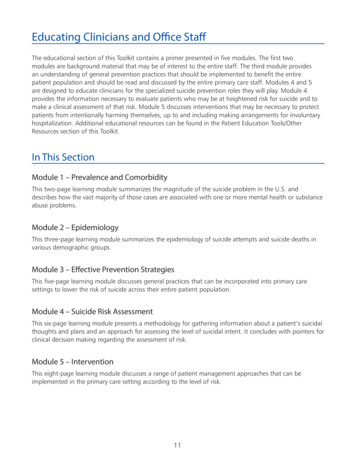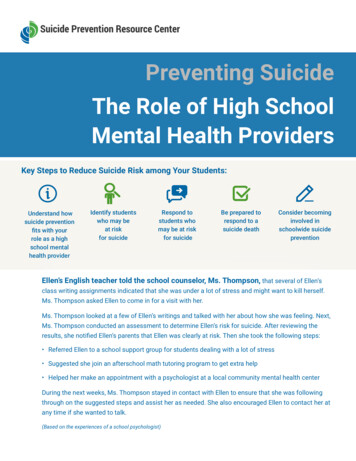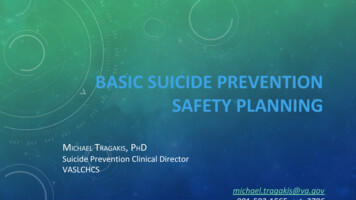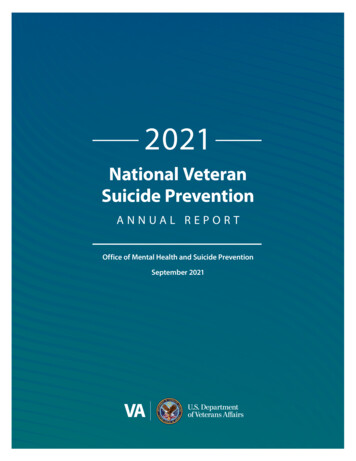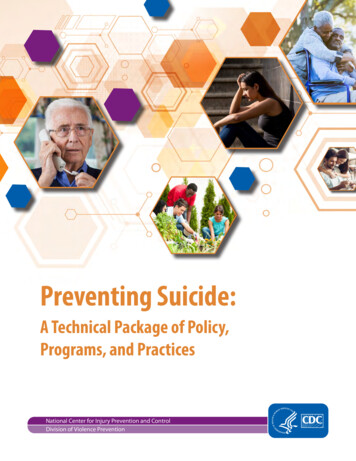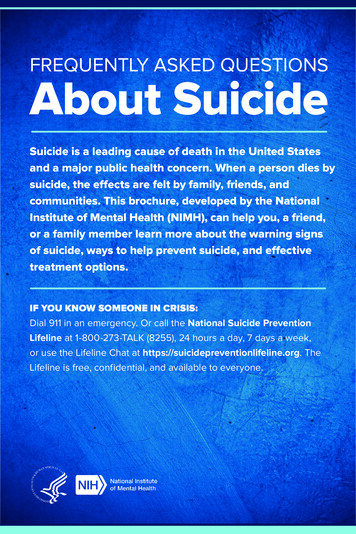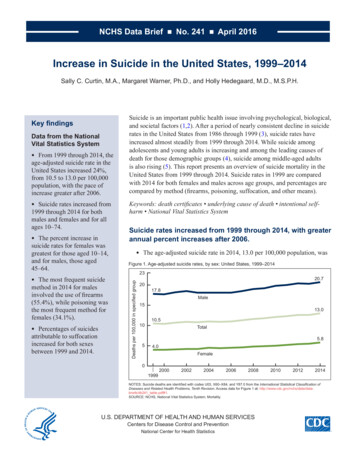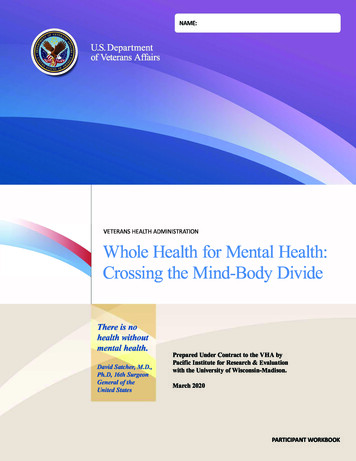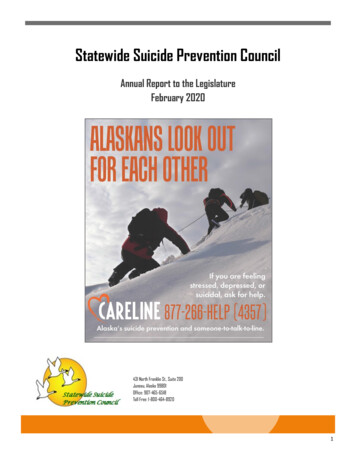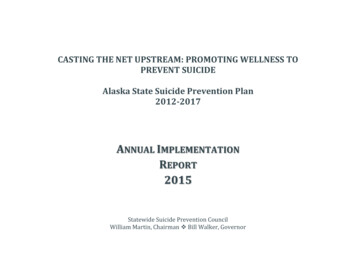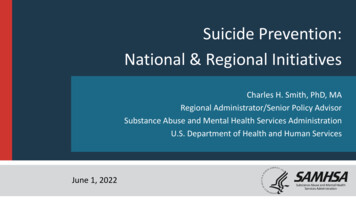
Transcription
Suicide Prevention:National & Regional InitiativesCharles H. Smith, PhD, MARegional Administrator/Senior Policy AdvisorSubstance Abuse and Mental Health Services AdministrationU.S. Department of Health and Human ServicesJune 1, 2022
America’s Mental Health CrisisToo many people acrossIn 2020the U.S. Experiencethere was approximately onedeath by suicide every 11 minutessuicidal, mental healthIn 2020and/or substance usefor people aged 10–14 and25–34 years, suicide was thesecond leading cause of deathcrisis without thesupport and care theyFrom April 2020 to 2021needover 100,000 people died fromdrug overdoses2
Suicide and Suicide Prevention in the Context of COVID After declines in 2019 and 2020, preliminary 2021 mortality data from CDC indicate anincrease with 47,458 deaths, up from 45,979 in 2020. Previously CDC Mortality and Morbidity Weekly Review reported significant increases inAmericans seriously considering suicide. Increases were particularly significant for young adults, for people of color, for unpaidcaretakers, and for essential workers. Significant impact on the nation’s Emergency Rooms SAMHSA has been provided 100M in suicide prevention dollars SAMHSA has awarded 50 COVID Emergency Suicide Prevention grants. SAMHSA has expanded Lifeline & Disaster Distress Helpline services in preparation of 988.3 HHS Behavioral Health Coordinating Committee and White House InterdepartmentalPolicy Committee.
National Strategy for Suicide Prevention Developed by the U.S. Surgeon General and theNational Action Alliance for Suicide Prevention The National Strategy for Suicide Prevention (NSSP) isa comprehensive , multi-sectoral strategy to reducesuicide in America. Details 13 goals and 60 objectives for reducingsuicide over 10 years, including:o Integrating suicide prevention into health care policieso Encouraging transformation of health care systems toprevent suicideo Changing the way the public talks about suicide andsuicide preventiono Improving the quality of data on suicidal behaviors todevelop increasingly effective prevention efforts4
SAMHSA Suicide and Suicide Prevention GrantsSAMHSA Tribal Suicide Prevention Community Mental Health ServicesBlock Grant Governor’s Challenge to End VeteranSuicide Garrett Lee Smith State and TribalYouth Suicide Prevention Grant 988 State and Territorial Crisis Centers Garrett Lee Smith Campus SuicidePrevention Grant Innovative Community CrisisResponse Partnerships (just released,application due 7/25/22) Native Connections Grant Suicide Prevention Resource Center Zero Suicide Grant National Suicide Prevention Lifeline5
SAMHSA ResourcesSAMHSA Suicide Safe Mobile app6SAMHSA Suicide Prevention Resource Center
In the month before their death by suicide:“Suicide represents a worst-casefailure in mental health care. Wemust work to make it a ‘never event’in our programs and systems ofcare.” Half saw a general practitioner 30% saw a mental health professionalIn the 60 days before their death by suicide: Many licensed clinicians are not prepared 39% report they don’t have the skills toengage and assist those at risk for suicide 44% report they don’t have the trainingDr. Mike HoganNY Office of Mental Health10% were seen in an emergency department*Suicide prevention is a core responsibility forbehavioral health care systemsEducation Development Center Inc. 2015 All Rights Reserved.
Zero Suicide (www.ZeroSuicide.com) A priority of the National Action Alliance forSuicide Prevention A goal of the National Strategy for SuicidePreventionCore Components1.Leadership commitment2.Standardized screening and riskassessment3.Suicide care management plan A framework for systematic, clinical suicideprevention in behavioral health and healthcare systems4.Workforce development and training5.Effective, evidence-based treatment6.Follow-up during care transitions A focus. on safety and error reduction inhealthcare7.Ongoing quality improvement and datacollection A project of the Suicide PreventionResource Center A set of best practices and tools for healthsystems and providers8
A System-Wide Approach Saved Lives:Henry Ford Health System9 2015-2017 EDC, Inc. All Rights Reserved.
Colorado SuicidePreventionActivitiesSW CO AHECMay 2022
Care Transitions are Critical to Preventing Veteran Suicide In an era when we can track the location of a package halfway around the world,we can’t allow veterans to fall through the cracks of fragmented acute caresystems. Because acute care services cannot entirely eliminate suicide risk, continuingcontact through entire episodes of care is needed Veterans need pathways to care from community emergency and crisis systemsthat mirror what is provided within VA. Suicide deaths post-hospital discharge are significantly higher than other timeperiods
Three Focused Priority Areas Identify SMVF and Screen for Suicide Risk Promote Connectedness and Improve CareTransitionsoCare transitions reduced suicide risk behaviorby 20% Increase Lethal Means Safety and SafetyPlanning12
SAMHSA Region 8 - Regional Resource GuideSAMHSA Publications (http://store.samhsa.gov/home)Suicide PreventionNational and Region VIII ResourcesRegion VIII (2020) In 2017, nearly 47,173 suicide deaths (approximately one death every 12 minutes); 9.8 million adultsseriously thought about suicide; 2.8 million made a plan; and 1.3 million attempted suicide (CDC, 2017). Suicide is the 10th leading cause of death for adults; 2nd leading cause of death for youth (CDC, 2017). Suicide rates increased from 29,199 deaths in 1996 to 47,173 deaths in 2017 (CDC, 2017).SAMHSA Suicide Prevention and InterventionSAMHSA’s goal is to provide individuals, families, professionals, and organizations with information and resources to seekhelp, provide assistance, and implement effective suicide prevention programs in their communities. National Suicide Prevention Lifeline (1-800-273-TALK (8255) - a free, 24-hour hotline available to anyone insuicidal crisis or emotional distress. Lifeline has more than 160 centers and is connected to the Veterans Lifeline National Action Alliance for Suicide Prevention - a public/private partnership that advances the National Strategyfor Suicide Prevention through the work of nearly 200 organizations. Preventing Suicide: A Technical Package of Policy, Programs, and Practices (CDC, 2018) - Features communityand state strategies to prevent suicide, decrease suicide risk factors, increase protective factors, and inform acomprehensive, multi-level and multi-sectoral approaches to suicide prevention within communities and states. National Strategy for Preventing Veteran Suicide (VA, 2018) - Purpose is to provide a framework for identifyingpriorities, organizing efforts, and contributing to a national focus on Veteran suicide prevention. National Governor’s Association, State Strategies for Averting Early Deaths: Innovations and Best Practicesfor Preventing Suicide (2019) - Report on intermountain rural state and tribal approaches to reduce rural suicide.National Strategy for Suicide Prevention (2012) - onalstrategy-suicide-prevention/full-report.pdf Suicide Prevention Program Evaluation Toolkit: Using Data to Inform Your Approach (RAND, 2018)SAMHSA Technical Assistance Centers SAMHSA Suicide Prevention Resource Center (SPRC): www.sprc.orgSAMHSA Technology Transfer Centers (TTC): �� Mountain Plains Mental Health Technology Transfer Center (University of North Dakota – Region VIII)American Indian/Alaskan Native Mental Health Technology Transfer Center (University of Iowa)SAMHSA Tribal Technical Assistance Center (TTAC): www.samhsa.gov/tribal-ttacSAMHSA Service Member Veteran and their Families Technical Assistance Center (SMVF TAC):www.samhsa.gov/smvf-ta-centerSAMHSA GAINS Center for Behavioral Health and Justice: www.samhsa.gov/gains-centerSAMHSA Funding (www.samhsa.gov) Garrett Lee Smith (GLS) Suicide Prevention/Tribal YouthSuicide Prevention Grant GLS - Campus Suicide Prevention Program Cooperative Agreements to Implement Zero Suicide inHealth Systems (Zero Suicide) SAMHSA/VA: Mayor’s Challenge to Prevent SuicideSAMHSA/VA: Governor’s Challenge to Prevent SuicideMental Health Awareness Training GrantsProject AWARE (mental health and school violence)Tribal/Native Connections GrantResources for Engaging Veterans 13VA Suicide Prevention Coordinator and Community Resource Locator ww.mentalhealth.va.gov/communityproviders/military resources.aspCommunity Health Providers Toolkitwww.veteranscrisisline.netVeterans Crisis spxMilitary Crisis Linehttps://psycharmor.org/PsychArmor InstituteoooooooSAMHSA Suicide Safe Mobile appTo Live to See the Great Day that Dawns: Preventing Suicide by American Indian/Alaska Native Youth & Young AdultsTIP 50: Addressing Suicidal Thoughts and Behaviors in Substance Abuse TreatmentStories of Hope and Recovery: A Video Guide for Suicide Attempt SurvivorsPromoting Emotional Health and Preventing Suicide: A Toolkit for Senior Living CommunitiesPreventing Suicide: A Toolkit for High SchoolBehavioral Health Treatment Services Locator (www.samhsa.org)Additional Resources www.nimh.govNational Institute for Mental Health (NIMH)www.suicidology.orgCenter for Disease Control and Prevention (CDC)www.ihs.gov/behavioral/index.cfm?module BH&option SuicideIndian Health Serviceswww.aas.orgAmerican Academy of Suicidologyhttps://afsp.org/American Foundation for Suicide Preventionhttps://nami.orgNational Alliance on Mental Illness uicide-Prevention.aspxAmerican Academy of Pediatricswww.wiche.eduWICHE - Suicide Prevention Toolkit for Primary Care Practiceswww.mantherapy.orgMan Therapy - an interactive mental health campaign targeting working age men (25-54)Region VIII Suicide Prevention ActivitiesPrevention Community Coalitions (CO, MT, ND, SD, UT, WY) Gate-Keeper Training (K-12, Schools, MT-Supreme Court,MT Primary Care) MHFA/YMHFA (CO, MT, ND, SD, UT, WY) Suicide Awareness Training (MT-Fish and Wildlife; WYYellowstone Park Rangers; MT-Coroners, COConstruction Workers; ND Pastors, Farmers/Ranchers) Gun Shop Project (CO, UT, MT) UT “Is Your Safety On?” Campaign: distributed 150Kcable-style gun locks & suicide awareness training forconceal-carry gun instructors Zero Suicide Academies (CO, SD, UT, MT)Crisis Services Rocky Mountain Crisis Partners (CO) CO Crisis Center System/Co-responder models UT CrisisLine and Mobile Outreach Team ND FirstLink Crisis System MT - Great Falls and Bozeman Crisis Lines & Help Centers SD - Sioux Falls Crisis Line and Help Center Crisis Intervention Training for Law Enforcement (UT, CO)Clinical Practice Sources of Strength (schools, tribes, hospitals)Universal Screening for Suicide Prevention (ND)Columbia Suicide Rating Scale & Safety Plans (MT, CO, UT)Training Clinicians in Post-Vention activities (ND, SD)High intensity transitional care (SD)Workforce UT (one of 7 states that requires bi-annual SuicidePrevention training for MH providers) Peer Navigators and Patient/Family Supports MT – Veteran Peer Support System-certificationRegion VIII Suicide Prevention DirectorsColorado, Department of Public Health & Environment, Suicide Prevention Director-Sarah Brummett sarah.brummett@state.co.usKrosston@mt.govMontana, Department of Health and Human Services, Suicide Prevention Coordinator - Karl Rosstonatraynor@nd.govNorth Dakota, Department of Health, Suicide Prevention Program Director - Alison TraynorJana.Sprenger@state.sd.usSouth Dakota, Department of Social Services, Suicide Prevention Manager- Jana Sprengerkmeyers@utah.govUtah, Department of Health, Suicide Prevention Coordinator - Kim MeyersLindsay.martin@wyo.govWyoming, Department of Health, State Suicide Prevention Coordinator - Lindsay MartinSAMHSA Regional Administrator – Region VIII: Charles Smith, PhD charles.smith@samhsa.hhs.gov
Region 8 State Suicide Prevention HighlightsColorado Colorado Office of Suicide Prevention(www.coosp.org) and the ColoradoDepartment of Health Care Policy andFinancing (Medicaid Authority) haveembedded elements of the Zero Suicideinto their Hospital Quality ImprovementIncentive Program which provides tohospitals and EDs engaged in suicideprevention workTaking the Follow Up Project statewidewhich provides continuing caringoutreach via telephone to folksdischarging from emergency departmentsafter a mental or behavioral health crisis,including overdose events regardless ofintent Scaling up the Colorado Gun Shop Project Expanding OperationVeteranStrong.org inpartnership with the VA Annual Bridging the Divide SuicidePrevention Conference (2/2022)South Dakota Implemented school-based SuicidePrevention Programs: Signs of Suicide;Peer Helpers; Sources of Strength (SOS) Developed Crisis Planning for Schoolsinitiative dedicating resources, protocolsand resources to support schoolsfollowing a death by suicide or suicideattempt: 1) Hazelden’s Lifelines’“Postvention: Responding to Suicide andOther Traumatic Death” and 2) endorsedmodel school district policy on suicideprevention (American School CounselorAssoc., National Assoc. of SchoolPsychologists, Trevor Project, AFSP) South Dakota Codified Law 13-42-71requiring suicide awareness andprevention training for all teachers,administrators, and other educationprofessionalsImplemented Text4Hope, crisis textingsupport for all high school studentsNorth Dakota North Dakota Division of BehavioralHealth has implemented Kognito (anonline, role-playing simulation to helpschool personnel learn to recognize thesigns of distress, use conversations toapproach a student, discuss concerns,and, if necessary, referparents/students to the appropriateresources) to all K-12 school personnelat no-cost North Dakota State University Extension Center has developedtargeted suicide prevention resourceson Farm and Ranch Stress(www.ag.ndsu.edu/farmranchstress) Promoted www.bethe1to.com tospread the word about actions we canall take to prevent suicide 5th Annual With Help There Is HopeConference (2/16/22)
Region 8 Suicide Prevention HighlightsUtahWyoming Initiated Live On, a statewide effort to preventsuicide by promoting education, providing resources,and changing our culture around suicide and mentalhealth. “Together we can get through, reach out, liftup, look ahead, and Live On” Initiated mental health first aid and suicideprevention training for park rangers Developed the Utah LGBTQ Suicide Prevention Plan(2020-2023) Wyoming is one of 35 states taking part in theGovernor’s Challenge on Suicide Prevention, apartnership with the Department of Veterans Affairsand SAMHSA to develop and implement state-widesuicide prevention best practices for servicemembers, veterans, and their families. Developed/implemented the SafeUT app toimmediately connect person in crisis to a licensedcounselor via live chat, 24/7/365. Applications for 1)students, parents, and educators, 2) front-lineworkers (LE, Fire/EMS, healthcare), & 3) NationalGuard University of Utah initiated Accelerate LearningCommunity, critical peer to peer support on stressand suicide15 Provided Introduction to firearms and suicideprevention training across the state 5/27/22 - WY Governor Mark Gordon unveiled YouMatter, a mental health public awareness campaignwhich features information on how to reach out forhelp via phone (1-800-273-TALK) or text (741741)and informational posters distributed at all Wyomingstate parks and historic sites (partnership withWyoming State Parks and Cheyenne RegionalMedical Center)
“Game changer in how we think about crisis response 988 is a once-in-a-lifetime opportunity to strengthen crisisresponsiveness. ”Dr. Miriam E. Delphin-RittmonAssistant Secretary SAMHSA, former Connecticut DMHAS Commissioner and previously Adjunct Associate Professor at Yale Universityand Director of Cultural Competence and Research Consultation with the Yale Program for Recovery and Community Health.
What is the Crisis Nowmodel?Call Center HubMobile CrisisCrisis Facilities“Air Traffic Control” Crisis CallCenter Hub Connects andEnsures Timely Access andData
Publications & ToolkitsPreventing Suicide: A Toolkit for High Schools19
SAMHSA’s mission is to reduce the impact of substance use and mental illnesson America’s communitieswww.samhsa.gov1-877-SAMHSA-7 (1-877-726-4727)1-800-487-4889 (TDD)20Charles H Smith, PhD, MARegional Administrator/Senior Policy AdvisorCharles.smith@samhsa.hhs.gov
2 America's Mental Health Crisis In 2020 there was approximately one death by suicide every 11 minutes In 2020 for people aged 10-14 and 25-34 years, suicide was the
